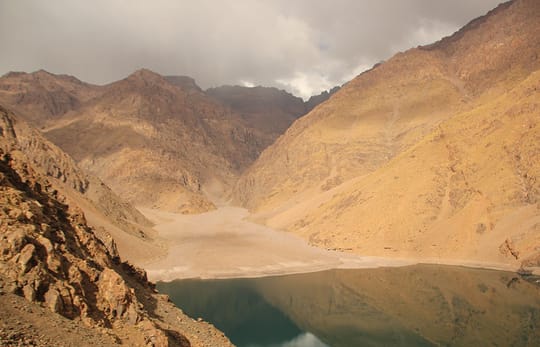By Ramzi Talbi
24/05/2016
Our trip to Ighil with High Atlas Foundation took us into deep Morocco. Ighil is small town in the Al Houz province of Marrakech, the population of which is mainly Berbers. The Berber communities are known for their strong connection to the land and its natural resources. Wool work is one the main activities for Berber Women at home. It starts with raising sheep and grooming them, which produces wool for carding, knitting, dyeing and the results are beautiful blankets, rugs, and warm sweaters that help them to survive the harsh winter in the Atlas Mountains.
In Ighil, we were welcomed by Mr. Ali, one of the elders of the village. His daughter, Maryam, is one of the local activists and the head of one of the local women’s associations. After a nice mint Tea break at Mr. Ali’s house, we went to the local Mosque where the workshop was held.
Amina, our wool dyeing expert, wants to teach the women at Ighil how to use plants to make natural dyes for the wool they use to make Berber rugs. One of our goals at HAF is to help the women in this rural community create a cooperative together, which will improve their financial life and help their families.
The workshop took place at one of the rooms in the local mosque, which is also the place where these women learn how to write and read. We were surprised by how many women showed up for the workshop, and I was impressed how eager these women were to learn. They brought their own raw wool with them and as soon as they arrived, they start carding the wool and singing beautiful songs in Berber. Shortly after the room was packed with women, Amina started the workshop by going over the old technique of making dyes using plants. This natural way of making beautiful colors is safer for both the environment and people. Normally, the process of dyeing wool takes ten days but to make the training more fruitful for the whole group, but since the workshop was only one day, Amina went over all three steps of dyeing wool:
1. Wash wool with natural black soap
2. Boil water and alum and soak wool in it for two days
3. Boil water with plants chosen for each color, and soak wool in it for five days
The result is magical! Amina used some locally sourced plants to dye the raw wool. Some of these plants include henna leaves for an earthy red, olive leaves for light green, chamomile flower for a yellow, pomegranate peels for a brighter red, walnut peels for browns and madder roots for various reds and pinks.
Cost efficient: Using plants for dyeing wool is cheap; the main ingredients are native plants that they grow naturally in the region.
During the workshop, we had a Tea break with local dry walnuts and almonds followed with homemade Assida, typically Berber meal made with corn, homemade butter and served with butter milk made by Haj Omar’s family; He is one of the elders as well.
Everyone in the group was very happy about the training and couldn’t thank Amina and HAF enough for the efforts in helping of the development of Ighil.
After the workshop, Mr Ali and his family insisted that go for lunch at his house. We end up having a tasty meal for lunch and had Tea, Jamal, our Master degree volunteer in foreign applied languages is working on Ighil women’s cooperative proposal interview Mr Ali about the history of the town, current challenges they are facing and what’s the future planned projects for the town. After lunch we walked back to the Mosque to check the room where the Women’s currently handwoven Berber Rugs, the space is small and doesn’t have enough equipment for the local community.
At the end of our day, we walked along the houses and trees toward our car to go back to Marrakesh. Next to the main road to Ighil Mr Ali and Haj Omar, showed us the spot where they are hoping to build tree floor building for the women’ cooperative
